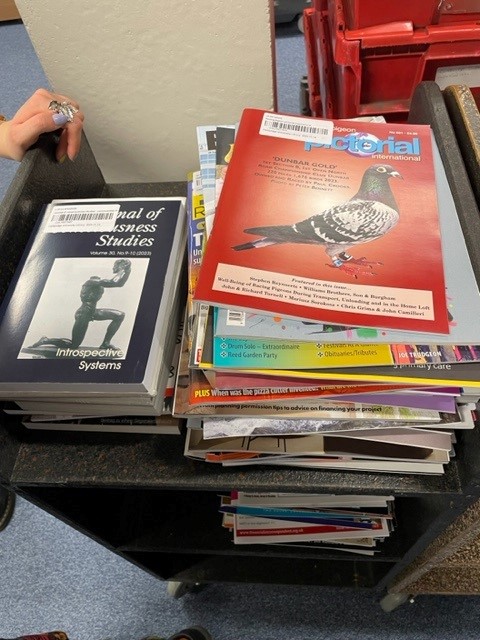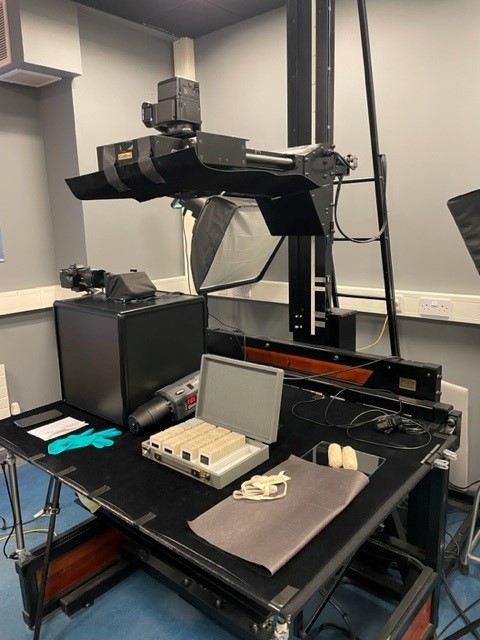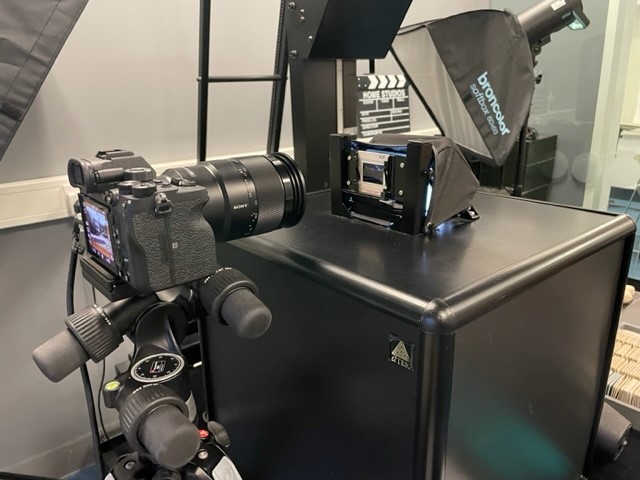Legal Deposit

After finishing our lunch at Queens College, we scurried back into the University Library. Our tour now descended into the lower levels of the building, where we convened with the Head of Legal Deposit. Over the next hour, we were given an insightful overview of the history, legal and ethical considerations of the Legal Deposit, and a sneak-peek into how the day-to-day operations are ran.
As previously highlighted by Anna in part one, it was interesting to learn more about Cambridge University Library being one of six libraries sanctioned under the Legal Deposit Libraries Act. The purpose of the Legal Deposit is to preserve the UK and Ireland’s published literature, both physical and digital, and protect it for future researchers and students. As trainee librarians, we recognise the necessity in protecting published literature as part of our national heritage and were interested to learn more.
The University Library Legal Deposit receives one copy of every published item in the UK and Ireland, and they are all processed here in the Legal Deposit. As a result, the collection of published materials at the University Library are enormous! The materials include magazines, journals, books, pamphlets, pretty much anything which has been made available to the public by publishing is collected here at the Legal Deposit. In addition to physical materials, the deposit legislation has covered digital and online material for future records of websites, e-journals, e-books, and blogs.

The Legal Deposit team were busy at work. With several children’s magazines lying across the desk (including the beloved Bluey) awaiting to be received by the Legal Deposit Team, it was amazing to think that in the future; this could form a part of significant research for future generations. Amongst children’s books, the Legal Deposit also receives cooking books, train timetables, flyers from football matches…the list goes on. In the morning, during the tour, we had also had a quick opportunity to explore the racks of magazines and periodicals and going to the legal deposit team highlighted the work that goes behind such collections.
We were provided an example of how the published health promotional materials of the 1980’s AIDS epidemic were collected via the Legal Deposit. It is now significant material for researchers and provides a unique insight into culture and health politics during that specific period; this had several of us thinking about how documentation of the COVID-19 pandemic might function similarly in the future. Further discussions were had about censorship and how the library manages certain literature items which may have a potential to cause harm. It was explained that some items are only accessible under strictest conditions due to the nature of what the document might contain. For example, if there were to be a medical book with prescribing errors in it, such as incorrect dosage sizes; this sort of material would only be accessible for specific research purposes only and there are several procedures in place to ensure it is only accessed for this reason.

The influx of published material at the Legal Deposit is constant and takes a team of highly dedicated and efficient staff to ensure things run smoothly. Further explanation was given that they receive anywhere from 40-60 boxes of published material per week. The Legal Deposit can be seen as a triaging area, identifying academic, and non-academic material and where the material will be retained. All items are catalogued to provide quick access to relevant materials for students and researchers. There is a long-term storage facility based in Ely to help manage space across the University Library of Cambridge and is primarily used for non-academic literature storage. Once an item has been selected to be externally stored; it is processed at the Legal Deposit and then transferred to the Ely storage centre.
The Digital Content Unit

Our next stop was the Digital Content Unit (DCU). We were greeted by one of the DCU photography team members, who explained the purpose, protocols, and procedures of the DCU. We were ecstatic when we were informed that we were also going to see the DCU team in action as they work on the special collections.
The DCU is where we can see the past, present and future of special collections being carefully curated by experts providing imaging and licensing services for the library’s collections. We spent the next hour with the photography team who specialize in providing high-quality imaging services. Digital images produced have included 16th century maps of Cambridge, Isaac Newton’s notebook and Charles Darwin’s letters amongst many of the other items which we saw earlier in the Manuscript room.


We were given a tour of the DCU and introduced to the rest of the photography team, and we witnessed their digital imaging techniques live in action. We were astounded by the photographic technology and skill it takes to reproduce such high-quality digital images of the University Library’s special collections. Due to the delicate nature of the collections, the technology provides an innovative way for research and education to continue without over manipulation of fragile objects and protects the materials integrity. The DCU follows strict protocols to ensure that their images produce the most accurate representation of the material. In one of the work rooms, colour film slides of Africa in the 90’s were being digitized after they were donated.
The team ensures that cameras and light are calibrated to specific settings to ensure highest quality reproduction of an item. This becomes quite challenging with the larger fragile items such as large maps, hefty scrolls, and big paintings. The DCU has specialist equipment in place to facilitate accurate image taking, photographs can be taken in sections and then sewn together digitally for the most continuous and accurate reproduction of a large object. This echoed the stitching technique we had heard of earlier in the day being employed in the map room and showed how all the teams in the library rely on each other and function together. The XY Table (as photographed) is an automated machine which provides precision controlled horizontal movement. This helps to ensure flat surfacing of the larger objects when taking digital images.


For fragile books and manuscripts, we witnessed gentle air suctioning machines being used in conjunction with the conservation cradle to ensure that the pages lie flat for precise image taking. This helps to prevent damage to the bindings.
The DCU also had 3D photogrammetry for physical objects. Using photographic and AI technology, in one pass of the camera hundreds of digital photographs of an object are taken at rapid speed and then collated together for a seamless view of an object. The images can be used for 3D reproduction of an item so the replica of a rare artefact can be held, manipulated, and examined for further research and educational purposes. Several replicas which were made using this technique were shown to us. This included a 2,200 B.C Sumerian tablet as well as an 18th-century pocket globe which travelled with Captain Cook! We were given the unique opportunity to hold these objects and closely examine the details. Next, it was time to see the 3D photogrammetry technology live in action, so one of our fellow trainee’s bravely volunteered to be turned into a 3D image, alongside a PG Tips monkey. The results were most impressive, and we were all a stunned by how startlingly realistic the results were! The team were working on 3D photogrammetry imaging of the Spitting Image: A Controversial History exhibition at the University Library, so we also got to see how this is utilised in the curatorial activities of the library.
We learned about how the DCU also specializes in multispectral imaging. Multispectral imaging can examine documents under different light wavelengths such as UV and infrared to see hidden objects. This allows information unseen to the human eye to be discovered. It’s particularly useful for investigating an object to discover under layers of writing, faded or erased text or other anomalies in various media. We also learned during our tour that Cambridge University Library have been part of the Polonsky Foundation Greek Manuscripts Project which focuses on digitising, cataloguing, and conserving Modern Greek and Medieval Manuscripts. We were informed about a research project entitled ‘Curious Cures’ which explored medieval manuscripts, books, and notes recovering details which may have been erased. With this technology, researchers are now able to identify what was once present. This digital imaging technique allows deeper investigation into a book’s history using non-invasive measures, whilst minimising the risk of damage to the book itself.
The Tower

This took us to our final stop of the day, where we were kindly escorted up into the tower. As we emerged from the dark photography rooms of the DCU, we could see that our day at the University Library was coming to an end, and it would soon be dusk.
To reach the 157ft Tower; we were given an option of taking the lift or fourteen flights of stairs! One of our daring trainees loves taking stairs so they opted for the latter as the rest of us preferred to take the lift at a more relaxed pace.


The tower seems to be clouded in mystery as it has limited access to most users. Liam explained that it was originally seen as a secondary storage area for items with limited significance, but it is now a treasure trove of colourful first editions and wonderfully kept children’s books and Edwardian fiction, including cultural fictional classics. This shows how difficult it is to determine what is of value and worth keeping and preserving when working in libraries. We took the time to wander and explore the books stored in the tower which were full of vibrant illustrations, and superbly preserved books in their original dust jackets, with many 20th century novels.

We made our way over to the windows; with stunning views over Cambridge at sunset, the tower offered us a moment of tranquillity from what was a full and illuminating experience for us. This was a perfect way to end our day with a tour of the University Library Tower.
With almost 15,000 steps counted for the day, we all left feeling inspired (and perhaps just a bit tired). We all had a fantastic day exploring and touring the University Library and getting to meet their passionate team working diligently behind the scenes. A huge thank you to the University Library Team for hosting and introducing us to their departments. Through sharing their passion and vast knowledge, our visit to the University Library was everything we hoped for.

